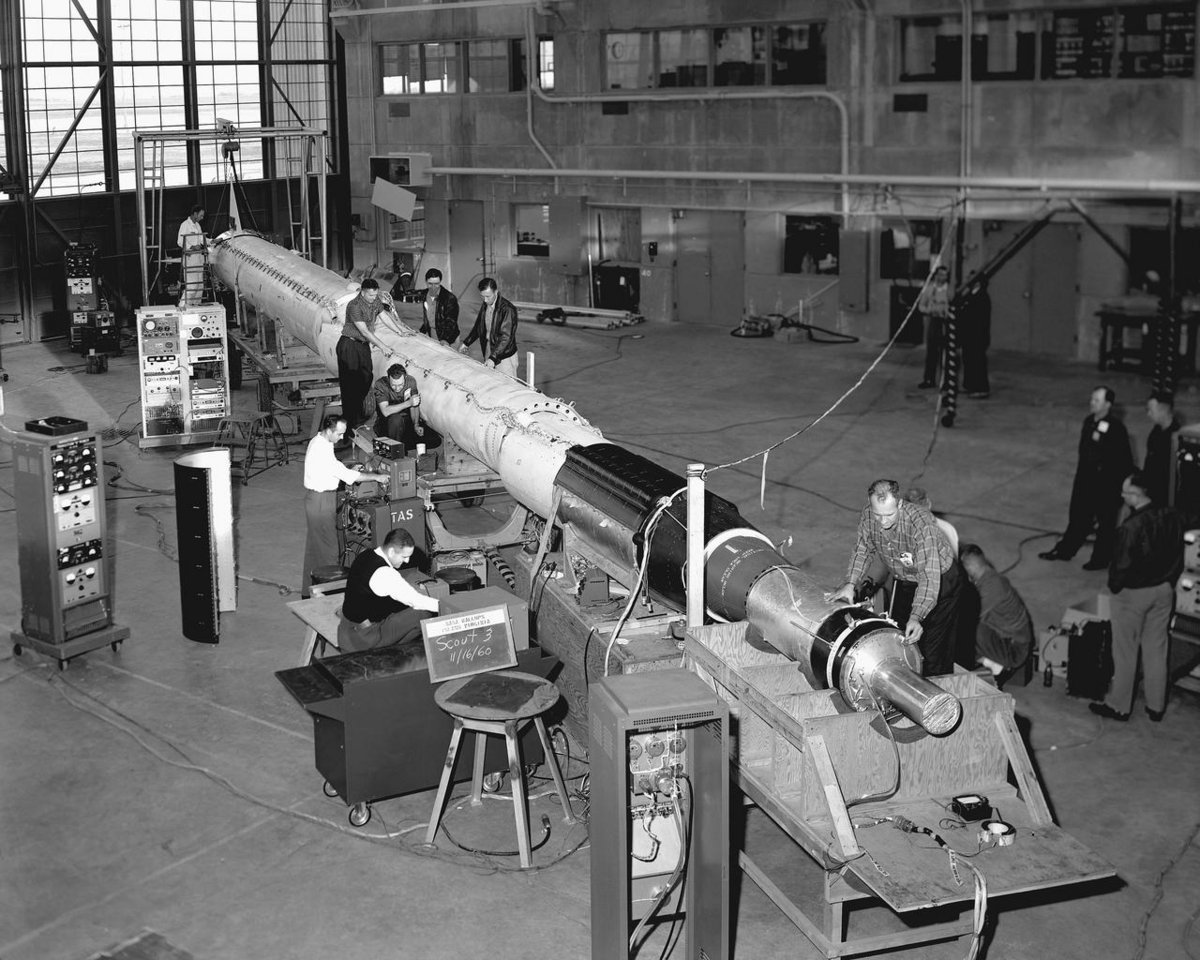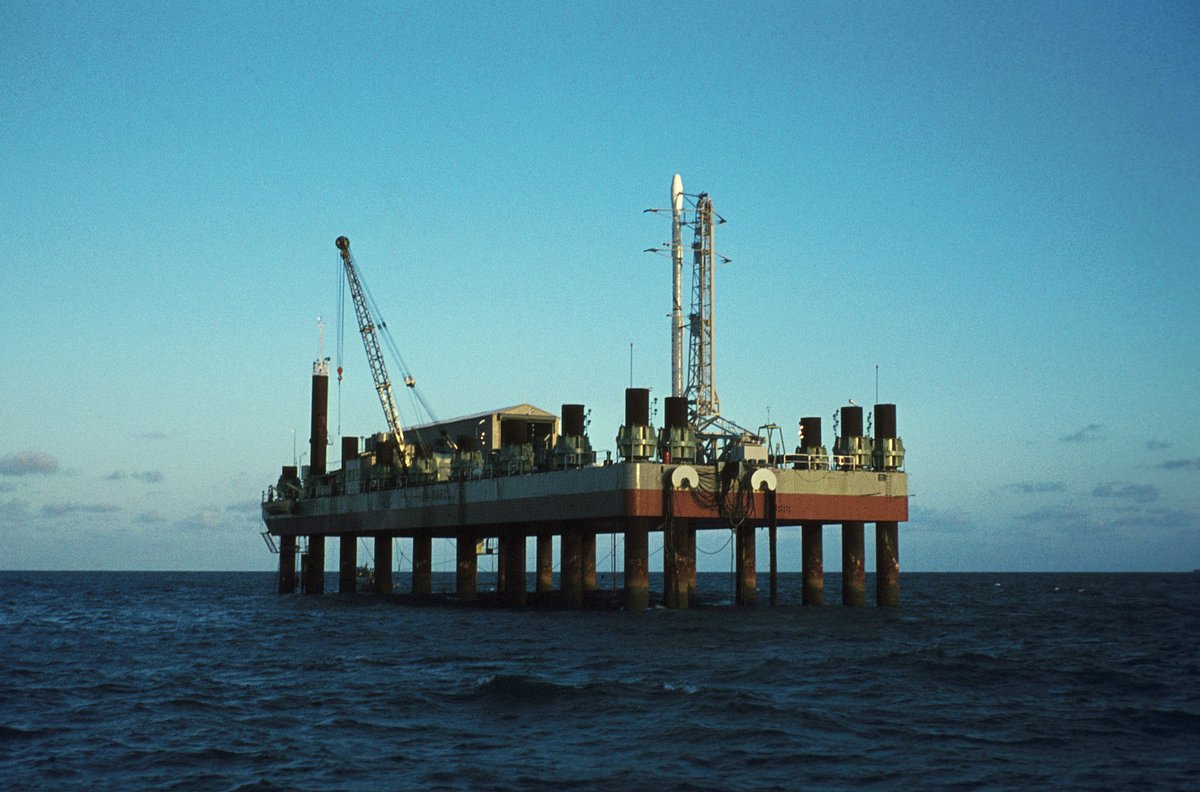Designed even when the United States had not sent any satellites into orbit, the small Scout rocket had a surprising career all around the world. However, this very first solid propellant launcher did not have the ambition to remain on the front of the stage for more than 30 years!
Simple, reliable, and above all… civil.
No, not a missile
In the race for the first American take-off into orbit, it was noted that the efforts were too divided between the three main branches of the American armies, each developing its own launcher. Jupiter for the US Army, Vanguard proposed by the US Navy, and Atlas, late, but pushed by the US Air Force.
There were, however, other projects already underway at the time, including Scout. The latter is the result of developments initiated by NACA, the ancestor of NASA after 1956, during the first conclusive tests of solid rocket boosters. These powerful propellants, although their combustion cannot be stopped, can be stored, and above all, are very reliable. The US Navy is interested in it, with a focus on ballistic launches by ballistic missile submarines (the Polaris missile). This is also the case of the US Army, and this will lead to the Sergeant missile.
The NACA, at the heart of the development, retains civil use rights for this technology and associated elements. And for a time, they fall into oblivion. In 1958, the United States used other launchers for its first satellites before assembling civil space activities and creating NASA. But Scout does not remain in the drawers for as much. Indeed, there is no question of keeping only the most capable launchers. NASA needs a reliable rocket, which it can build without going through the military, for small-scale civilian satellites and tests for its Mercury program. In March 1959, the Scout project was back on track. The US Air Force is participating, but will have its own version, leaving the young NASA with a civilian project.
Little Scout will stay small
On 21st century criteriae century, Scout is almost a microlauncher: between 16.2 and 21 tonnes (depending on the version) on the scale, between 21 and 25 meters high, and just over a meter in diameter at its base. It is made up of 4 stages with “solid” powder propulsion, and this is the first time on a planetary scale. The first, named Algol, comes from research with the US Navy. The second, Castor (XM-33), is being developed with the US Army. Finally, the third, Antares, and the fourth, Altaïr, already existed with the Vanguard launchers.
The advantage of powder stages also lies in the simplification of infrastructures. Indeed, at the time, launchers evolved quickly, and Scout was no exception. However, with this launcher, there is no need for heavy modifications of the launch sites, because it is fast, and no need for large tanks or cryogenic propellants either.
Scout X, not a Gaulish name
The first test version is called Scout X and aims for a suborbital dish for its maiden liftoff on April 18, 1960. This is from the Wallops site in Virginia and goes well, although the rocket disintegrates during the launch. separation between the first and the second floor. Regardless, NASA then moves on to full-scale tests.
With the 4 floors mentioned above, we are now dealing with the Scout X1 version. The takeoff took place on July 2, 1960 and failed. It will be overtaken on October 4 by a successful suborbital launch, enough to encourage the teams to aim for orbit with a small 7.5 kg sphere, Explorer 9. The launch takes place on December 4 and is also a failure, during of the action from the second floor. Definitely!
There are doubts about the management of the project on the NASA side, especially since the first version resulting from military work, Blue Scout, succeeded in its inaugural takeoff a month later. But the team did not give up, and on February 16, for the first time, Scout X1 carried a satellite into low orbit, a sphere identical to Explorer 9. Moreover, it is still there and will remain there for several centuries. , having reached an altitude of 757 x 2,433 kilometers… Scout’s career was launched.
As you will have noticed, Scout X1 was not an extraordinary technical success, and things were not going to get much better in 1961. Despite everything, the launcher managed to successfully test components dedicated to the Mercury program, and NASA already in the works an improved version of its small vehicle, X2. Incrementally, the developments will allow over the years to improve the reliability of the flight, but also the power available, and therefore the capacity to orbit.
There will be 24 versions in all, between prototypes, suborbital and orbital versions, for civilians or the military, capable of carrying up to 220 kg in low orbit! But that’s not the most interesting, or even the fact that NASA and the US Air Force used this rocket from their three major launch sites, Wallops, Vandenberg and of course Cape Canaveral. What marked history is that from the first success in 1961, NASA, with its small civilian rocket, took the opportunity to promote access to space.

Who wants to use Scout?
Determined to design and launch its first satellite, Italy was the first to approach NASA in 1961. From Sardinia, the Italian Air Force (AMI) had in fact already collaborated with American suborbital rockets for experiments scientists. Just over 3 years after the start of the “space race”, the authorities know that they do not have the technical means for a major rocket program. The idea of a collaboration was then born, knowing that the Italians wanted to acquire skills and operate a launch site of their own.
The agreements are quickly tied (then formalized in 1962) with NASA, which can offer Scout, a civilian launcher, without having to go through a defense commission. This is the beginning of the San Marco program, which gives rise to a maritime platform at the Broglio Space Center, on the coast of Kenya. Nevertheless, a first Italian satellite, San Marco 1, took off on December 15, 1964 from the Wallops site. Italy becomes the fourth nation to have a satellite in orbit, after the United States, the USSR and the United Kingdom. The latter took advantage of his “special relationship” with the United States to prepare and send his own Ariel units with the help of Scout, once again.

The Franco-Scout, the best Scout?
Did you know that Scout almost sent the first French satellite into orbit? It is even our country’s first scientific satellite, designed by CNES (Astérix, the first satellite, was designed by SEREB), and it was called FR-1.
The successful launch of the French Diamant A rocket at Hammaguir was followed only 10 days later by that of Scout with FR-1, from the Vandenberg site. France will not be the largest “customer” of the United States with this rocket offered throughout the Western world, but it has also benefited from the service. This is also the case for the Netherlands, which is sending its first satellite with Scout, as well as for Europe in space. Partly the ancestor of the ESA, the ESRO (European Space Research Organisation) also flew with the prolific little American launcher.

It is not yet the advent of commercial space as we know it today. It is then too early, and it is the States, and not the companies, which negotiate the launch services. But Scout, however small and efficient it may be, already foreshadows the desire of the Americans to make orbit available as a service, and not as a tool only available to the national agency and the military. Its use will decline over the decades, but Scout will take off until 1994, with a total of 125 launches and 118 successes around the world. Not bad, for a rocket whose design dates back to 1956…

2